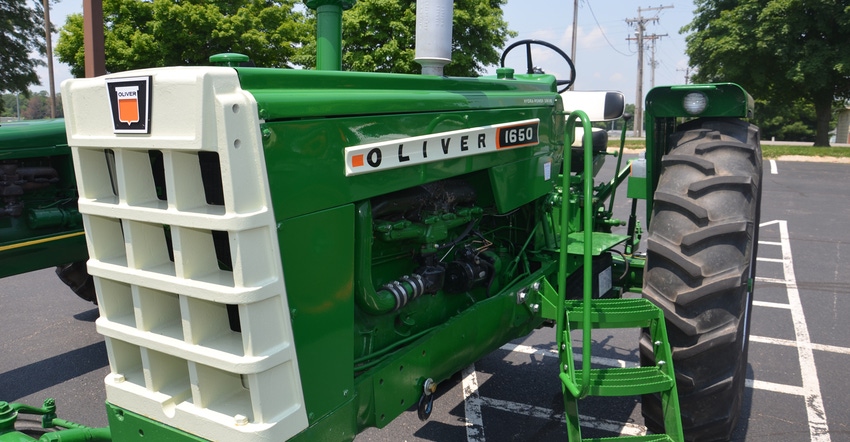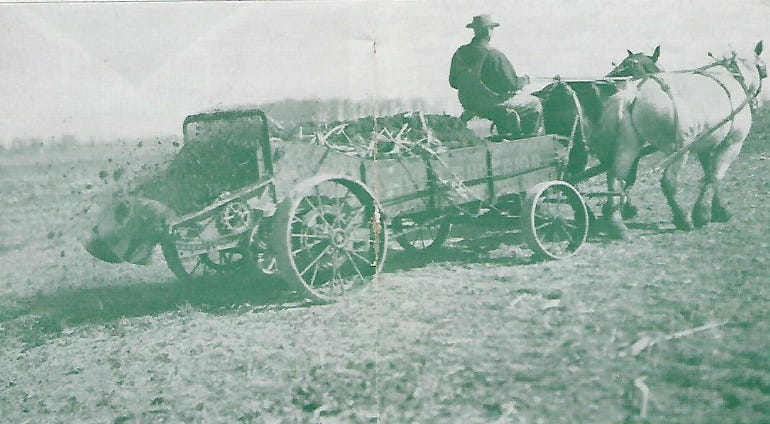February 14, 2019

Oliver didn’t survive for decades just because farmers liked its paint scheme. In fact, the horse-drawn Oliver Superior 75-A manure spreader wasn’t even green and yellow. Authentic literature depicts it as orange with yellow steel wheels and yellow lettering.
What caught farmers’ attention was Oliver’s ability to produce a quality product with advanced technology for the times. The Superior manure spreader is an example. According to literature featuring both a schematic drawing and an actual photo of the spreader in action, it featured six “powerful” tempered steel coil springs strategically placed on the axles and above the wheels to cushion the ride for the operator sitting on the seat just ahead of the spreader and behind a team of horses.
Here’s how Oliver literature for the 75-A spreader describes it: “This feature, first introduced on the Oliver Superior 75, proved outstandingly successful. The springs are mounted, two on the oscillating front axle and two on each rear-wheel bearing. The size and strength of these springs are so worked out as to completely cushion the load. They act as shock absorbers from jolts and jars from any or all wheels, just as on an automobile.”
Advanced tech
That wasn’t the only comparison Oliver literature writers made between the manure spreader, of all things, and early automobiles. The writers noted that the front wheel mounting and steering were also of the “automotive” type.

CLASSIC RIDE: No, it’s not a car. It’s an Oliver manure spreader with suspension like that used in cars of the day, as well as automotive-like steering.

Steering was direct from the tongue, the literature says, through high carbon steel steering rods. The literature claims the spreader could make a complete turn in a 14.5-foot circle — not bad considering it was pulled by horses.
The spreader pivoted on the inside rear wheel. The front axle didn’t pivot. Adding more technology of the day, the rear axle used the “railroad-type journal box bearing and spring suspension.”
In advertising the spreader, Oliver nearly always emphasized the suspension feature. “Spring-hung and wide-spread” were the buzz words of the day that spokesmen used to describe the spreader.

PSEUDO SHOCK ABSORBERS: The spring design that buffered the ride over rough ground on Oliver’s Superior 75 and 75-A manure spreaders was revolutionary for its time.

Oliver history
Eventually all Oliver manure spreaders would be pulled by tractors, many of them Oliver tractors, not horses. Octane Press just released the second edition of “Classic Oliver Tractors,” a 160-page softcover book with tons of color photographs. It follows Oliver as a company from 1855, when James Oliver bought a quarter-share of the South Bend Foundry, to 1976, when the last tractor bearing the Oliver name rolled off the assembly line.
The book is written by Sherry Schaefer, herself steeped in Oliver history. The Greenville, Ill., native’s grandfather was an Oliver dealer, and her father is a dealer in used Oliver tractors and equipment. She started as editor of the Hart-Parr Oliver Collector’s magazine in 1993. The book will be available soon at a retail price of $40. To learn more about this newest edition of a classic tractor book, visit octanepress.com.
Comments? Email [email protected].
You May Also Like




